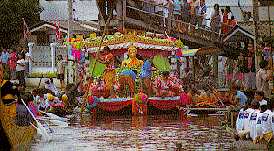
The pagoda of Pra Samut Chedi

| Amphoe Muang
|
Out of City Attractions
|


 |
|
 Festival and Celebrations in Samut Prakan
Festival and Celebrations in Samut Prakan
 Luang Por Toh, a Buddha image of people. |
|
|
|
|
: Tourism Authority of Thailand, 4 Ratchadamnoen Nok Avenue, Bangkok 10100, THAILAND.
: Tourist Service Center (TAT and Tourist Police), Tel. 1155 : Tourism Authority of Thailand Tourist Service Center : Visiting Samut Prakan Province, Festive Holidays, KINNAREE, Thai Airways International Ltd., May 1998, P. 42. |